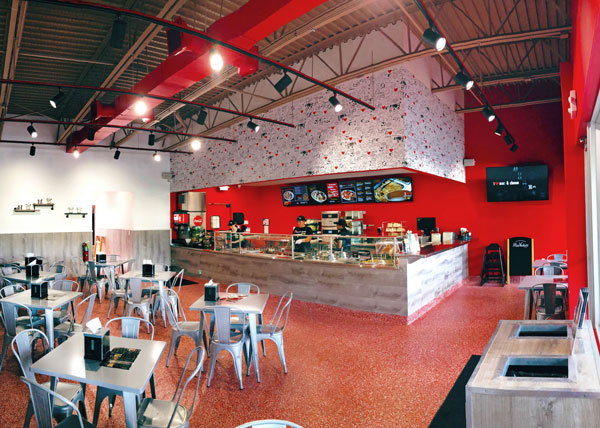 By Sam Darwish, President and CEO, Skinny IT www.skinnyit.comThe IT industry is constantly evolving, and new technology continues to have a profound impact in restaurants across the country. We are at a point in time where technology is beginning to outpace our imaginations and is changing the way we interact with the world around us. Digital innovations and smart devices have permanently made their way into our pockets, attached to our wrists and integrated into our daily lives in ways we could not fathom 10 years ago.
By Sam Darwish, President and CEO, Skinny IT www.skinnyit.comThe IT industry is constantly evolving, and new technology continues to have a profound impact in restaurants across the country. We are at a point in time where technology is beginning to outpace our imaginations and is changing the way we interact with the world around us. Digital innovations and smart devices have permanently made their way into our pockets, attached to our wrists and integrated into our daily lives in ways we could not fathom 10 years ago.
Because of recent innovations, technology now plays a significant role in the success and growth of the restaurant industry. From the latest point-of-sale (POS) systems, mobile applications, intricately designed TV displays, state-of-the-art kiosks and virtual menus, the digital standard in restaurants continues to rise. Restaurant owners who wish to stay competitive within the industry need to adopt technological innovations or be left behind.
When opening a new restaurant, owners have a lengthy checklist of tasks they need to accomplish. From hiring and training staff members to designing the space and ensuring all technology components work together seamlessly, it can be easy to miss something.
Technology should be at the top of that to-do list. A solid IT infrastructure is one of the most important tools a restaurant must utilize because a simple technology glitch can wreak havoc on the success and reputation of the business. Restaurant owners do not have the bandwidth to deal with IT issues; therefore, it is essential to hire an IT partner that you can rely on and trust.
In order to ensure success within the industry, restaurant owners should plan out their IT infrastructure in the following three phases:
Phase 1: Construction and Design
When opening a new restaurant, it is essential to plan ahead. Think through all IT needs before construction begins. This is important because a lack of planning in the early stages could lead to design flaws discovered when it’s too late to make major changes. For example, if plans call for a large TV display on a wall, plans must include having an outlet and cable source nearby to avoid stringing and extending cables throughout the restaurant. Planning technology components ahead of time is essential to ensure a well laid-out building that is mindful of IT infrastructure.
At this point in the process, a restaurant owner should not be talking with a potential IT provider. Instead, focus on making a wish list of IT components you would like to include. Once you have compiled your list, the next step is to talk with your designer and construction managers to lay out the design of the restaurant and plan for the desired IT components.
While this may seem tedious, planning out IT components ahead of time will help set the foundation for success. Restaurant owners who jump straight into the construction phase before planning tend to find themselves in trouble later in the process.
Potential IT items a restaurant owner might want to include are:
- Cabling
- Computer and network needs
- Data collection from customers
- Digital menus
- Digital promotional screens
- Intercom systems
- Linked network of cash registers
- Music systems
- Physical and cyber security systems
- POS systems
- Receipt printers
- Surveillance cameras
- Wi-Fi access
- And more as new technology components are constantly evolving
Phase 2: Research and Interview
Once the list of IT necessities has been developed and the layout of the restaurant has been approved, it is time to start researching and interviewing potential IT partners. Take the list of IT components you have developed, and use it to find the company that will be able to supply all of your technology needs. Restaurant owners should not settle for an IT provider that cannot supply each and every item on their list. A good provider should always offer customized solutions tailored to the specific needs of each restaurant as opposed to a one-size-fits-all approach. Finding an IT partner at this phase of the process will ensure a smooth transition from groundbreaking to grand opening.
Some restaurant owners assume they should hire a local IT provider. Location should never hinder the decision to hire the IT partner that is the right fit for your business. Some providers are headquartered in one location but have trusted teams throughout the country, so they can service clients anywhere. If the IT company desired is located out of state, it is important to ensure that it has a representative or team that is located nearby to provide immediate service, installation, maintenance and issue management. A reliable IT partner should be able to provide services anywhere, regardless of geographic location.
Additionally, restaurant owners who choose to use multiple IT providers to supply various IT needs are truly doing themselves and their business a disservice. This is a mistake many restaurant owners make that will ultimately prove to be an inefficient use of time, resources and money. The use of multiple IT providers is not recommended because if the restaurant is experiencing technological difficulties with more than one component, that’s two providers you now have to call, two schedules to coordinate and two bills that you must pay. Hiring one trusted provider to handle all IT components will ultimately save time and money. An IT provider should act as a team member working with the restaurant, striving for mutual success and adapting as the restaurant grows and evolves.
Phase 3: Open for Business
Once the restaurant is up and running, owners should continue to have consistent and regular communication with their IT provider. New restaurants have kinks to work out during the initial months of being open. A restaurant owner should rely on their IT partner as an extension of their business. It is wrong for a restaurant owner to think otherwise.
A common mistake many restaurant owners make is failing to provide their staff with adequate technology training prior to opening. Before the restaurant opens, have the IT team conduct a technology training session with all restaurant staff to ensure each individual knows how to work the equipment properly. The more employees know about the IT components within a restaurant, the more prepared they will be to handle a minor glitch if needed. Reputation is everything within the restaurant industry; therefore, it is essential to take every precaution necessary to ensure an IT issue does not negatively affect your restaurant.
For the first few months the restaurant is open, schedule weekly check-in calls with your provider to talk through how IT components are working. This is an opportunity for team members to ask any questions they have and work out any issues that can be handled over the phone. After a few months, check-in calls will no longer be necessary; however, this does not mean it is acceptable to lose touch with your provider. It is a restaurant owner’s responsibility as a leader to ensure their team has all the tools necessary to succeed.
A reliable IT provider should come on-site for a visit once every quarter to take a closer look at all technology components and ensure everything is working correctly. This is also a good time for them to replace or update technology. For example, if the POS system you use has recently been upgraded to include more security features, your IT provider can update all systems when they conduct their quarterly check-in. Restaurant owners who fail to schedule quarterly check-ins with their IT provider are at risk of falling behind by operating with out-of-date technology that could harm their business.
Additionally, it is beneficial to take the time during your quarterly visit to ask your provider for recommendations as to how you could be running the business more efficiently from a technological perspective. A trusted IT partner should not use this opportunity to sell you more equipment or services but instead should utilize every tool it has to help your restaurant succeed.
As the restaurant industry continues to grow, it has never been more important for owners to understand how technology plays a vital role in their ongoing success. Leaders and innovators within the restaurant industry should expect to see technology continue to play a significant role as IT tools are growing in popularity. Ten years ago, we could not fathom half of the IT gadgets we have grown accustomed to using every day. Now, imagine what innovations will be developed within the technology industry within another 10 years. The amount of technology we use and see in our everyday lives will only continue to grow. Restaurants that prioritize their technology needs and hire an IT partner committed to the longevity of their business will find success and stand out in the competitive food service industry.



